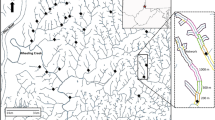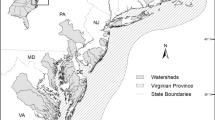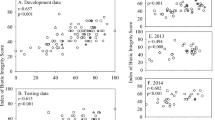Abstract
Do land use and cover characteristics of watersheds associated with small estuaries exhibit a strong enough signal to make landscape metrics useful for identifying degraded bottom communities? We tested this idea with 58 pairs of small estuaries (<260 km2) and watersheds in the U.S. Mid-Atlantic coastal plain (Delaware Bay to Chesapeake Bay). We considered 34 landscape metrics as potential explanatory variables and seven estuarine parameters as response variables. We developed three logistic regression models: one to calculate the probability of degraded benthic environmental quality (BEQ), as defined by chemical parameters, and two for the probability of degraded estuarine bottom communities, one using a benthic index (BI) and a second using the total number of bottom-dwelling species (TNBS, consisting of benthic macroinvertebrates and fishes). We evaluated the discriminatory power of the models with ROC (receiver operating characteristic) curves of sensitivity and specificity. All three models showed excellent discrimination of high and low values. A model using the sum of all human land uses and percent wetlands correctly classified BEQ in 86% of the cases; low benthic index and low total number of bottom species were each associated with degraded BEQ (p<0.01). The BI model used percent riparian urban, riparian wetlands, and agriculture on steep slopes (76% correct classification) and correctly predicted high-low benthic index of an independent data set 79% of the time (p<0.05). The TNBS model used percent wetlands, riparian wetlands, and riparian agriculture (74% correct classification). Watersheds with higher percentages of urban and agricultural land uses were associated with lower benthic environmental quality, benthic index, and biodiversity, whereas those with higher percentages of wetlands were associated with higher numbers. As human development of watersheds increases, statistical prediction rules developed from landscape metrics could be a cost-effective method to identify potentially threatened estuaries.
Similar content being viewed by others
Literature Cited
Basnyat, P., L. D. Teeter, K. M. Flynn, andB. G. Lockaby. 1999. Relationships between landscape characteristics and nonpoint source pollution inputs to coastal estuaries.Environmental Management 23:539–549.
Brettburg, D. 2002. Effects of hypoxia, and the balance between hypoxia and enrichment, on coastal fishes and fisheries.Estuaries 25:767–781.
Clarke, K. R. andR. M. Warwick. 2001. Change in marine communities: An approach to statistical analysis and interpretation. PRIMER-E Ltd., Plymouth, U.K.
Comeleo, R. L., J. F. Paul, P. V. August, J. Copeland, C. Baker, S. S. Hale, andR. L. Latimer. 1996. Relationships between watershed stressors and sediment contamination in Chesapeake Bay estuaries.Landscape Ecology 11:307–319.
Correll, D. L., T. E. Jordan, andD. E. Weller. 1992. Nutrient flux in a landscape: Effects of coastal land use and terrestrial community mosaic on nutrient transport to coastal waters.Estuaries 15:431–442.
Dauer, D. M. 1993. Biological criteria, environmental health and estuarine macrobenthic community structure.Marine Pollution Bulletin 26:249–257.
Dauer, D. M. andR. W. Alden, III. 1995. Long-term trends in the macrobenthos and water quality of the lower Chesapeake Bay (1985–1991).Marine Pollution Bulletin 30:840–850.
Dauer, D. M., J. A. Ranasinghe, andS. B. Weisberg. 2000. Relationships between benthic community condition, water quality, sediment quality, nutrient loads, and land use patterns in Chesapeake Bay.Estuaries 23:80–96.
Deegan, L. A., J. T. Finn, S. G. Ayvazian, C. A. Ryder-Kieffer, andJ. Buonaccorsi. 1997. Development and validation of an estuarine biotic integrity index.Estuaries 20:601–617.
Desmond, J. S., D. H. Deutschman, andJ. B. Zedler. 2002. Spatial and temporal variation in estuarine fish and invertebrate assemblages: Analysis of an 11-year data set.Estuaries 25: 552–569.
Ebert, D. W., T. G. Wade, J. E. Harrison, andD. H. Yankee. 2002. Analytical tools interface for landscape assessment (ATtILA). Quick Start Guide, Version 3.0. U.S. Environmental Protection Agency, Office of Research and Development, Las Vegas, Nevada.
Environmental Systems Research Institute (ESRI). 1998. ESRI data and maps. ESRI, Redlands, California.
Gallagher, E. D. andK. E. Keay. 1998. Organism-sediment-contaminant interactions in Boston Harbor, p. 89–170.In D. D. Stolzenbach and E. E. Adams (eds.), Contaminated Sediments in Boston Harbor. MIT Sea Grant College Program, Cambridge, Massachusetts.
Gergel, S. E., M. G. Turner, J. R. Miller, J. M. Melack, andE. H. Stanley. 2002. Landscape indicators of human impacts to riverine systems.Aquatic Sciences 64:118–128.
Hale, S. S., M. M. Hughes, C. J. Strobel, H. W. Buffum, J. L. Copeland, andJ. F. Paul. 2002. Coastal ecological data from the Virginian Biogeographic Province, 1990–1993.Ecology 83: 2942 andEcological Archives E083-057.
Hopkinson, Jr.,C. S. andJ. J. Vallino. 1995. The relationships among man’s activities in watersheds and estuaries: A model of runoff effects on patterns of estuarine community metabolism.Estuaries 18:598–621.
Hosmer, Jr.,D. W. andS. Lemeshow. 2000. Applied Logistic Regression, 2nd edition. John Wiley and Sons, New York.
Hughes, R. M. andC. T. Hunsaker. 2002. Effects of landscape change on aquatic biodiversity and biointegrity, p. 309–329In K. J. Gutzwiller (ed.), Applying Landscape Ecology in Biological Conservation. Springer-Verlag, New York.
Inglis, G. J. andJ. E. Kross. 2000. Evidence for systematic changes in the benthic fauna of tropical estuaries as a result of urbanization.Marine Pollution Bulletin 41:367–376.
Jones, K. B., D. T. Heggem, T. G. Wade, A. C. Neale, D. W. Ebert, M. S. Nash, M. H. Mehaffey, K. A. Hermann, A. R. Selle, S. Augustine, I. A. Goodman, J. Pedersen, D. Bolgrien, J. M. Viger, D. Chiang, C. J. Lin, Y. Zhong, J. Baker, andR. D. Van Remortel. 2000. Assessing landscape condition relative to water resources in the western United States: A strategic approach.Environmental Monitoring and Assessment 64:227–245.
Jones, K. B., A. C. Neale, M. S. Nash, R. D. Van Remortel, J. D. Wickham, K. H. Riitters andR. V. O’Neill. 2001. Predicting nutrient and sediment loadings to streams from landscape metrics: A multiple watershed study from the United States Mid-Atlantic Region.Landscape Ecology 16:301–312.
Jones, K. B., K. H. Riitters, J. D. Wickham, R. D. Tankersley, Jr.R. V. O’Neill, D. J. Chaloud, E. R. Smith, andA. C. Neale. 1997. An ecological assessment of the United States, Mid-Atlantic Region: A landscape atlas. EPA/600/R-97/130. U.S. Environmental Protection Agency, Office of Research and Development, Washington, D.C.
Jordan, S. J. andP. A. Vaas. 2000. An index of ecosystem integrity for Northern Chesapeake Bay.Environmental Science and Policy 3:S59-S88.
Jordan, T. E., D. E. Weller, andD. L. Correll. 2003. Sources of nutrient inputs to the Patuxent River estuary.Estuaries 26: 226–243.
Karr, J. R. andE. W. Chu. 2000. Sustaining living rivers.Hydrobiologia 422:1–14.
Kiddon, J. A., J. F. Paul, H. W. Buffum, C. S. Strobel, S. S. Hale, D. Cobb, andB. S. Brown. 2003. Ecological condition of U.S. Mid-Atlantic estuaries, 1997–1998.Marine Pollution Bulletin 46:1224–1244.
Lerberg, S. B., A. F. Holland, andD. M. Sanger. 2000. Responses of tidal creek macrobenthic communities to the effects of watershed development.Estuaries 23:838–853.
Lianso, R. J., L. C. Scott, J. L. Hyland, D. M. Dauer, D. E. Russell, andF. W. Kutz. 2002. An estuarine benthic index of biotic integrity for the Mid-Atlantic Region of the United States. II. Index development.Estuaries 25:1231–1242.
Long, E. R., M. J. Hameedi, G. M. Sloane, andL. B. Read. 2002. Chemical contamination, toxicity, and benthic community indices in sediments of the lower Miami River and adjoining portions of Biscayne Bay, Florida.Estuaries 25:622–637.
Long, E. R., D. D. MacDonald, S. L. Smith, andF. D. Calder. 1995. Incidence of adverse biological effects within ranges of chemical concentrations in marine and estuarine sediments.Environmental Management 19:81–97.
Mallin, M. A., K. E. Williams, E. C. Esham, andR. P. Lowe. 2000. Effect of human development on bacteriological water quality in coastal watersheds.Ecological Applications 10:1047–1056.
Meeuwig, J. J. 1999. Predicting coastal eutrophication from land-use: An empirical approach to small non-stratified estuaries.Marine Ecology Progress Series 176:231–241.
Morrisey, D. J., S. J. Turner, G. N. Mills, R. B. Williamson, andB. E. Wise. 2003. Factors affecting the distribution of benthic macrofauna in estuaries contaminated by urban run-off.Marine Environmental Research 55:113–136.
Murdy, E. O., R. S. Birdsong, andJ. A. Musick. 1997. Fishes of Chesapeake Bay. Smithsonian Institution Press, Washington, D.C.
Murtaugh, P. A. 1996. The statistical evaluation of ecological indicators.Ecological Applications 6:132–139.
O’Neill, R. V., C. T. Hunsaker, andK. B. Jones. 1997. Monitoring environmental quality at the landscape scale.BioScience 47:513–519.
O’Neill, R. V., K. H. Ritters, J. D. Wickham, andK. B. Jones. 1999. Landscape pattern metrics and regional assessment.Ecosystem Health 5:225–233.
Paul, J. F., R. L. Comeleo, andJ. Copeland. 2002. Landscape metrics and estuarine sediment contamination in the Mid-Atlantic and southern New England regions.Journal of Environmental Quality 31:836–845.
Paul, J. F., K. J. Scott, D. E. Campbell, J. H. Gentile, C. S. Strobel, R. M. Valente, S. B. Weisberg, A. F. Holland, andJ. A. Ranasinghe. 2001. Developing and applying a benthic index of estuarine condition for the Virginian Biogeographic Province.Ecological Indicators 1:83–99.
Paul, R. W. 2001. Geographical signatures of middle Atlantic estuaries: Historical layers.Estuaries 24:151–166.
Pearson, T. H. andR. Rosenberg. 1978. Macrobenthic succession in relation to organic enrichment and pollution of the marine environment.Oceanography and Marine Biology Annual Review 16:229–311.
Porter, D. E., D. Edwards, G. Scott, B. Jones, andW. S. Street. 1997. Assessing the impacts of anthropogenic and physiographic influences on grass shrimp in localized salt-marsh estuaries.Aquatic Botany 58:289–306.
Ranasinghe, J. A., J. B. Frithsen, F. W. Kutz, J. F. Paul, D. E. Russell, R. A. Batiuk, J. L. Hyland, J. Scott, andD. M. Dauer. 2002. Application of two indices of benthic community condition in Chesapeake Bay.Environmetrics 13:499–511.
Rose, K. A. 2000. Why are quantitative relationship between environmental quality and fish populations so elusive?Ecological Applications 10:367–385.
Sala, O. E., F. S. Chapin, III,J. J. Armesto, E. Berlow, J. Bloomfield, R. Dirzo, E. Huber-Sanwald, L. F. Huenneke, R. B. Jackson, A. Kinzig, R. Leemans, D. M. Lodge, H. A. Mooney, M. Oesterheld, N. L. Poff, M. T. Sykes, B. H. Walker, M. Walker, andD. H. Wall. 2000. Global biodiversity scenarios for the year 2100.Science 287:1770–1774.
SAS Institute 2002. SAS/STAT User’s Guide, version 8. SAS Institute, Cary, North Carolina.
Siewicki, T. C. 1997. Environmental modeling and exposure assessment of sediment-associated fluoranthene in a small, urbanized, non-riverine estuary.Journal of Experimental Marine Biology and Ecology 213:71–94.
Smith, A. K., P. A. Ajani, andD. E. Roberts. 1999. Spatial and temporal variation in fish assemblages exposed to sewage and implications for management.Marine Environmental Research 47:241–260.
Strobel, C. J., H. W. Buffum, S. J. Benyi, andJ. F. Paul. 1999. Environmental Monitoring and Assessment Program: Current status of Virginian Province (U.S.) estuaries.Environmental Monitoring and Assessment 56:1–25.
Strobel, C. J., J. F. Paul, M. M. Hughes, H. W. Buffum, B. S. Brown, andJ. K. Summers. 2000. Using information on spatial variability of small estuaries in designing large geographic scale estuarine monitoring programs.Environmental Monitoring and Assessment 63:223–236.
U.S. Environmental Protection Agency (U.S. EPA). 2002. Research Strategy. Environmental Monitoring and Assessment Program. EPA/620/R-02/002. Office of Research and Development, U.S. Environmental Protection Agency, Research Triangle Park, North Carolina.
Valiela, I., K. Foreman, M. LaMontagne, D. Hersh, J. Costa, P. Peckol, B. DeMeo-Andreson, C. D’Avanzo, M. Babione, C.-H. Sham, J. Brawley, andK. Lajtha. 1992. Couplings of watersheds and coastal waters: Sources and consequences of nutrient enrichment in Waquoit Bay, Massachusetts.Estuaries 15:443–457.
Van Dolah, R. F., J. L. Hyland, A. F. Holland, J. S. Rosen, andT. R. Snoots. 1999. A benthic index of biological integrity for assessing habitat quality in estuaries of the southeastern USA.Marine Environmental Research 48:269–283.
Wahl, M. H., H. N. McKellar, andT. M. Williams. 1997. Patterns of nutrient loading in forested and urbanized coastal streams.Journal of Experimental Marine Biology and Ecology 213: 111–131.
Weisberg, S. B., J. A. Ranasinghe, D. M. Dauer, L. Schaffner, andR. J. Diaz. 1997. An estuarine benthic index of biotic integrity.Estuaries 20:149–158.
Sources of Unpublished Materials
Environmental Monitoring and Assessment Program (EMAP). Unpublished Data. EMPA web site, 2002. U.S. Environmental Protection Agency. http://www.epa.gov/emap
National Land Cover Data (NLCD). Unpublished Data. Multi-Resolution Land Characteristics Consortium web site, 2002. http://www.epa.gov/mrlc/nlcd.html
U.S. Geological Survey (USGS). Unpublished Data. 2002 National Hydrography Dataset. http://nhd.usgs.gov
U.S. Geological Survey (USGS). Unpublished Data. 2002 National Elevation Dataset. http://edcnts12.cr.usgs.gov/ned/
Author information
Authors and Affiliations
Corresponding author
Rights and permissions
About this article
Cite this article
Hale, S.S., Paul, J.F. & Heltshe, J.F. Watershed landscape indicators of estuarine benthic condition. Estuaries 27, 283–295 (2004). https://doi.org/10.1007/BF02803385
Received:
Revised:
Accepted:
Issue Date:
DOI: https://doi.org/10.1007/BF02803385




